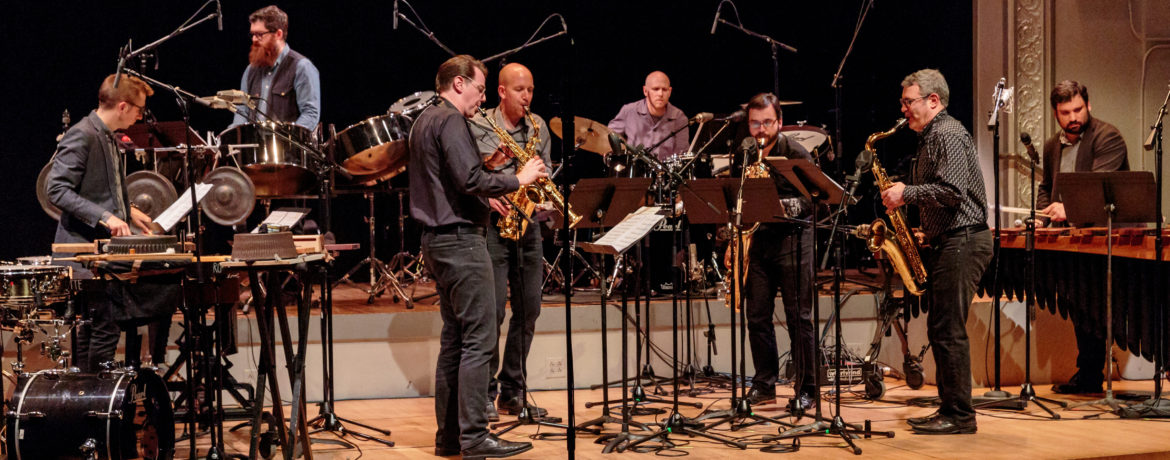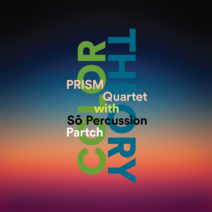Color Theory
World Premiere Recording
Stream or download: choose your preferred music platform.
Download from bandcamp (artist friendly)
Music for Saxophones, Percussion and Harry Partch Instruments
Track Listing:
Blue Notes and Other Clashes (2016) by Steven Mackey (b. 1956)
PRISM Quartet and Sō Percussion
1. Deep Hymn 4:24
2. Rustic Ballad 3:54
3. Off Waltz 1:58
4. Pale Lament 3:07
5. Mottled March 3:23
6. Dappled Grooves 2:39
7. Dirty Branle 2:34
8. Prismatic Fantasy 10:57
9. Future Lilacs (2016) by Ken Ueno (b. 1970)
PRISM Quartet, Partch, Derek Johnson, Stratis Minakakis
10. Skiagrafies (2016) by Stratis Minakakis (b. 1979)
PRISM Quartet, Partch, Stratis Minakakis
Read/download the iTunes booklet
Read/download the one sheet
Behind-the scenes photos
Musicians:
PRISM Quartet
Timothy McAllister soprano saxophone
Zachary Shemon alto saxophone, “hookah” saxophone
Matthew Levy tenor saxophone
Taimur Sullivan baritone saxophone
Sō Percussion
Eric Cha-Beach vibraphone, gongs, tom-toms, triangle, tin cans
Josh Quillen steel drums, roto-tom, cowbell, vibraslap, gongs,
tom-toms, marimba
Adam Sliwinski marimba, flexatone
Jason Treuting drum set, concert bass drum, singing bowl, vibraslap,
crotales, melodica
Partch
Erin Barnes diamond marimba
Alison Bjorkedal “Castor” canon, kithara
Matt Cook “Pollux” canon, kithara
David Johnson chromelodeon
John Schneider adapted viola
Nick Terry cloud chamber bowls
T. J. Troy bass marimba
Guest Artist (Future Lilacs)
Derek Johnson adapted electric guitar
Conductor (Future Lilacs and Skiagrafies)
Stratis Minakakis
Liner Notes by John Schaefer:
We have developed some pretty sophisticated ways of using language to describe music. But music remains such a slippery, elusive thing that we often find ourselves approaching it sideways—through a kind of linguistic sleight of hand. We use the language of the eye to describe this language of the ear: the names of major musical movements were taken from the visual arts (Classicism, Romanticism, Impressionism, Expressionism, Minimalism). And the metaphor of color has been used, to great effect, to talk about music for centuries, at least. In fact, the ancient classical music traditions of India are built on this metaphor: the word “raga” literally means “color.”
When the PRISM Quartet decided to commission a body of work built around the idea of musical colors, it seemed a natural next step for a group that has already created a substantial and diverse repertoire of music built around the almost infinitely variable sounds of the saxophone family. The sax has a long tradition in classical music, and rock, and even South Indian music; but its most famous players have been jazz musicians—from Coleman Hawkins to Charlie Parker to John Coltrane—whose sound was built around the so-called “blue” notes that are part of the fabric of jazz. So the members of the quartet had a deep connection with the idea of tone colors. But that wasn’t the Color Theory moment of genius. No, that came when PRISM decided to ask composers Steven Mackey, Ken Ueno, and Stratis Minakakis to write for the combination of saxophone quartet and percussion. There is no more kaleidoscopic palette in the instrumental world than in the percussion section—where over the years composers have placed such sonic oddities as bird calls, a record player, automobile parts, and the piano.
Color Theory pairs PRISM with two percussion-based ensembles: Sō Percussion, the New York-based quartet whose definition of “percussion” is liberal enough to include teacups, twigs, and fuzz; and Partch, the California-based ensemble that plays mid-20th century instruments designed by Harry Partch, whose 42-note-to-the-octave tuning system operates with a completely different sonic palette.
Credits:
Executive Producer, Editing, Mixing: Matthew Levy
Producers: PRISM Quartet; Steven Mackey, Ken Ueno, and Stratis Minakakis
co-produced their own compositions
Session Engineer: Peter Tramo
Mastering: Katsuhiko Naito
Photography, Design, Layout: Jon Rohrer, fluxism.com (JR)
Additional Photography: Scott Friedlander (SF), Taimur Sullivan (TS)
Recorded in Philadelphia, PA at Rittenhouse Soundworks
Jim Hamilton, owner
Tracks 1–8 recorded June 6–7, 2016
Track 9–10 recorded June 12–13, 2016
Funding Acknowledgement
Major support for Color Theory has been provided by The Pew Center for Arts & Heritage, with additional support from The Presser Foundation, the Alice M. Ditson Fund of Columbia University, and New Music USA, made possible by annual program support and/or endowment gifts from Mary Flagler Cary Charitable Trust, Rockefeller Brothers Fund, Anonymous.
Header photo by Scott Friedlander
UPC:
864190000215
Guest Artists:
Sō Percussion; Partch; Derek Johnson, adapted electric guitar; Stratis Minakakis, conductor
Record Label / Catalogue Number:
XAS 102
Release Date:
April 14, 2017





